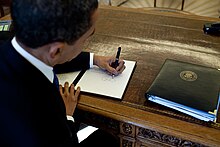This article may require cleanup to meet Wikipedia's quality standards. The specific problem is: organization. (July 2020) |

| ||
|---|---|---|
|
Personal
Illinois State Senator and U.S. Senator from Illinois 44th President of the United States Tenure
 |
||
The energy policy of the Obama administration was defined by an "all-of-the-above" approach which offered federal support for renewable energy deployment, increased domestic oil and gas extraction, and export of crude oil and natural gas.[1] His presidency's first term was shaped by the failure of his signature climate legislation, the American Clean Energy and Security Act, to pass, and then climate and energy disasters including the Deepwater Horizon oil spill in 2010 and then Hurricane Sandy, which took place during the 2012 election. In his second term, Obama lifted the ban on crude oil exports and approved liquified natural gas exports; his planned regulatory approach to reducing greenhouse pollution in the electricity sector, the Clean Power Plan, was blocked by the U.S. Supreme Court. [2]
On April 13, 2015, in honor of the 40th anniversary of Earth Day, the Obama Administration website summarized the initiatives that the administration was taking or had undertaken:[3]
- A $3.4 billion Smart Grid Investment Grant (part of the American Recovery and Reinvestment Act of 2009), which would affect 49 states and has the potential to reduce electricity use by more than 4% by 2033,[4]
- The launch of the Advanced Research Projects Agency-Energy (ARPA-E) project under the Department of Energy and in collaboration with the Department of Defense, modeled after the Defense Advanced Research Projects Agency,[5]
- A new report on how the federal government can help create a "self-sustaining home energy efficiency retrofit industry"[6]
- New efficiency standards for home appliances,[7]
- A new National Fuel Efficiency Policy that will apply to cars from model years 2012-2016 and will ultimately require cars to have an average fuel efficiency of 35.5 mpg by 2016,[8]
- Three measures to increase the production of biofuels: a renewable fuels standard, biomass crop assistance program, and a biofuels working group. The President has also created an interagency task force to help create a federal strategy for carbon capture and storage, and[9]
- A new Environmental Protection Agency ruling (called the Mandatory Reporting of Greenhouse Gases Rule) requiring the reporting of greenhouse gas emissions by major emitters in the United States.[10]
- ^ New Report: The All-of-the-Above Energy Strategy as a Path to Sustainable Economic Growth Energy & Environment
- ^ "West Virginia v. EPA" (PDF). June 30, 2022.
- ^ www.whitehouse.gov Building a New Foundation for Energy and the Environment April 13, 2010
- ^ www.whitehouse.gov President Obama Announces $3.4 Billion Investment October 27, 2009
- ^ www.whitehouse.gov Fact Sheet: A Historic Commitment to Research and Education April 27, 2009
- ^ Council on Environmental Quality, Recovery Through Retrofit October 2009
- ^ www.whitehouse.gov Remarks by the President on Energy June 29, 2009
- ^ www.whitehouse.gov President Obama Announces National Fuel Efficiency Policy May 19, 2009
- ^ www.whitehouse.gov Obama Announces Steps to Boost Biofuels, Clean Coal February 3, 2010
- ^ Environmental Protection Agency Mandatory Reporting of Greenhouse Gases Rule April 6, 2010

